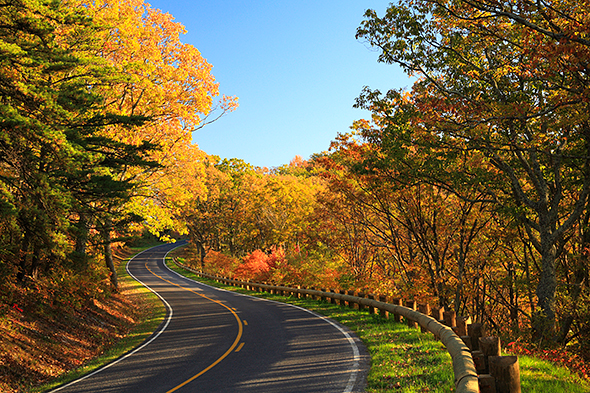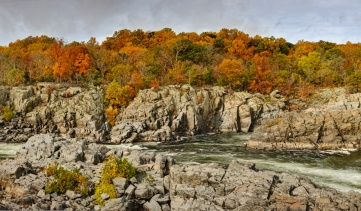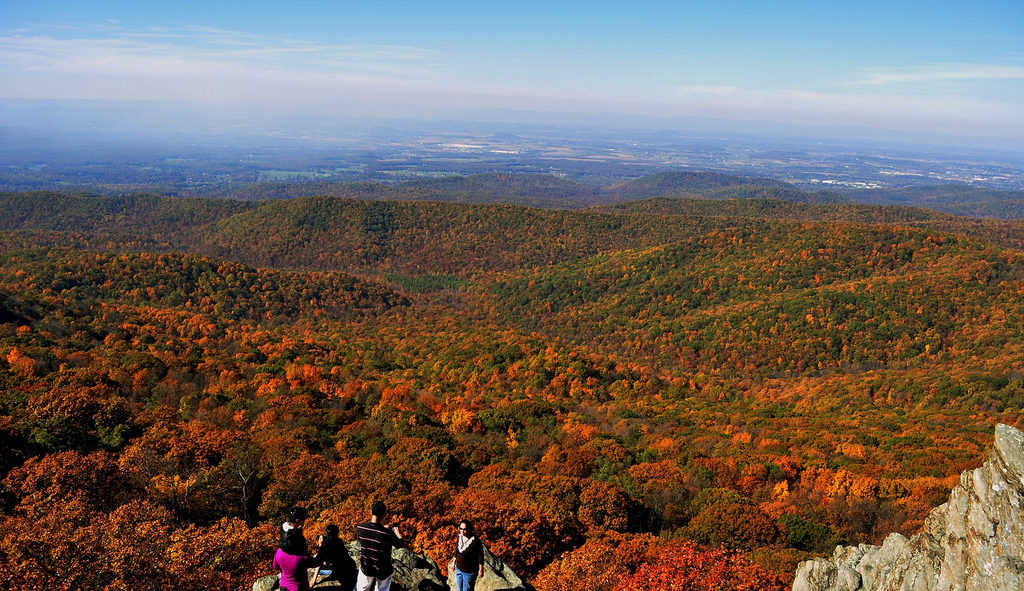
Fall is a favorite time of year for a lot of residents in the DC area. Between apple picking, festivals, pumpkin patches, and the changing leaf color Fall gives area residents a lot of fun activities to participate in. And when it comes to fall color, we are lucky to live near some of the most beautiful shows of fall foliage in the nation. Between our national parks, dedicated green spaces, and tree-lined backroads our area offers a spectacular view of yellows, oranges, reds, and purples. Read on to learn what weather conditions make colors pop, what trees turn what colors, the peak color dates this year, and where to see the best color.
What Makes Colors Pop
To understand what type of weather creates the best color profile you first have to understand why and how leaves change color in the first place.

All the colors that you see in fall are already present in the leaf; however, the constant influx of chlorophyll (what makes leaves green) during the spring and summer keep the fall colors from showing. As the days get shorter and the nights longer, the tree begins the process of sealing off its leaves so it can shed them in preparation for winter. This process blocks the chlorophyll from entering the leaf causing the fall pigments to become visible. The yellow and orange hues are caused by the organic pigments, xanthophyll and carotenoid, present in the leaves. The red and purple pigments (anthocyanins) are created from the sugars that are trapped in the leaf.
Although these pigments will show every fall, certain weather conditions can make these colors more vibrant.
Factors That Make Fall Leaf Color Pop:
Abundant Sunlight: After the leaf is sealed off, abundant sunlight will cause the chlorophyll to be destroyed more rapidly and fall colors to show more brightly.
Cool Temperatures (Especially At Night): Cool temperatures promote the formation of red and purple pigments. However, you don’t want it to be too cold. Early frosts will harm the colorful foliage.
Spring & Early Summer Rain/Moisture: Drought during the growing season can cause the leaves to be sealed off too early and cause the leaves to drop before they change color. Ample moisture in the growing season will keep this from happening. Unfortunately, this summer’s drought will probably cause a short and duller viewing season.
The best conditions for spectacular leaf color is a growing season with ample moisture followed by a dry fall with warm sunny days and cool but frostless nights.
What Tree Makes What Color?
The common trees in our area are ashes, beeches, dogwoods, hickories, oaks, populars, and red maples. They range in color from light yellow to deep purple. Below is a list of what color each tree’s foliage turns during fall.
| Tree | Fall Leaf Color |
| ash | yellow, maroon |
| beech | yellow to orange |
| dogwood | scarlet to purple |
| hickory | golden bronze |
| oak | red, brown or russet |
| poplar | golden yellow |
| red maple | brilliant scarlet |
When Is Peak Color?
The timing of peak color is hard to predict. Every day affects the prediction and rapid weather changes can speed up or slow down the color progression. In general, the best fall color happens between October 10th-20th in the mountains, October 15th-25th in central and northern Virginia, and October 20th-31st in eastern Virginia.
According to SmokyMountain.Com’s fall foliage map, they predict peak color around Oct 26th this year.
If you want to keep an eye on the color progression in the Shenandoah Mountains or want to check out the color before taking a road trip to the mountains, check out the NPS’s Shenandoah Fall Color Webcam.
Where Are The Best Places To See Color?
Although you can enjoy fall foliage almost everywhere in the DC Metro Area many residents head to local and national parks to take in the changing colors. Below are 4 spectacular options for seeing fall color. Because of their beauty, these spots tend to be popular and can be crowded. We suggest hitting these spots early in the morning to beat the rush.
Skyline Drive:

This 3-hour drive with 75 overlooks offers stunning views of the Shenandoah Valley. With a speed limit of 35 mph, Skyline drive allows you to relax, roll down the windows, and experience all the changing leaf colors in this stunning fall foliage drive. Most common tree species on Skyline Drive include; chestnuts and red oak on the ridge tops and upper slopes, yellow poplars on the lower slopes and streams, and maple, birch, ash, and basswood on the mid-slopes.
Great Falls Park & Riverbend Park:

Great Falls Park and Riverbend Park are convenient spots for those that want to see beautiful views without venturing too far away from home. Situated on 800 acres along the Potomac river, you’ll be able to see bright fall foliage that overlooks the falls and river at Great Falls Park. Viewing platforms at this park are wheelchair accessible.
Right next door is Riverbend Park which is about 400 acres along the Potomac River. This part of the river is calmer so you won’t see waterfalls; however, you will see lots of fall foliage overlooking the scenic river as well as wildlife and wildflowers. At this park, you can take in the fall colors while kayaking, canoeing, or fishing. Common tree species seen at these parks include; hickory, oak, poplar, maple, and basswood.
Billy Goat Trail:

The Billy Goat Trail is great for Marylanders that want to experience fall foliage without venturing into Virginia. The hike is 4.7 miles that follows a path between the C&O Canal and the Potomac River. The unique thing about this trail is that it is filled with views of endangered species of plant fauna. The most common tree species seen at Billy Goat Trail include; hickory, oak, and poplar.
Humpback Rocks – Blue Ridge Parkway

Get ready to experience 360-degree views of the Shenandoah Valley. Humpback Rocks is a short 1.0-mile climb but don’t let that fool you. Within a mile, this trail ascends 800 feet and is a tough climb but the views are worth it even for novice hikers. The most common tree species seen at Humpback rocks include; red cedar, sugar maple, red maple, and eastern white pine.
To see more places to find spectacular fall foliage check out our 10 Best Places To See Fall Color blog post.


